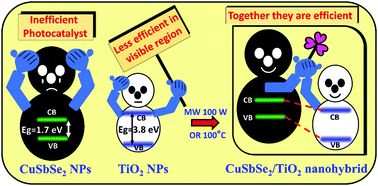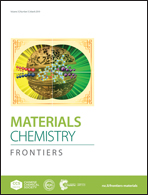CuSbSe2/TiO2: novel type-II heterojunction nano-photocatalyst†
Abstract
In this study, we report band gap engineering via hybridization of the group I–V–VI compound semiconductor, i.e., copper antimony di-selenide (CuSbSe2) nanoparticles (NPs) with TiO2 NPs for the effective degradation of organic dyes. The formation of a novel type-II heterojunction nanostructured material was accomplished by thermal and microwave (MW) methods using separately synthesized CSSe and TiO2 NPs. The changes observed in the characteristic properties of the hybrid as compared to those observed in its parent semiconductors proved the successful combination. The optical properties of the hybrid material showed the combined effects of CSSe and TiO2, resulting in absorption in the visible region with new band gap energy. XRD analysis indicated the presence of diffraction peaks due to anatase TiO2 and orthorhombic CSSe NPs, which confirmed the effective nano-hybrid formation; also, the crystal structure of the parent materials was retained. Surface attachment of smaller TiO2 particles around CSSe NPs with spherical morphology is evident from the TEM images. As-formed CSSe/TiO2 nanohybrids obtained using MW and thermal methods were evaluated as photocatalysts against three major organic dyes, viz., methylene blue (MB), methyl orange (MO) and Rhodamine B (RhB). The degradation efficiency obtained against all three dyes was higher in the case of the CSSe/TiO2 hybrid prepared using the MW method. The rate of degradation was evaluated using first order kinetics. This is the first report on a novel CSSe/TiO2 type-II heterojunction as a photocatalyst for the efficient degradation of organic dyes.



 Please wait while we load your content...
Please wait while we load your content...